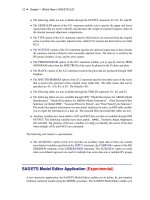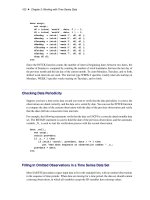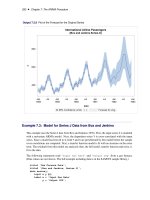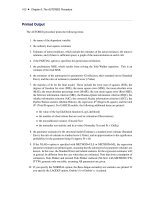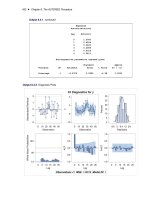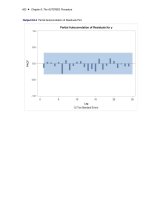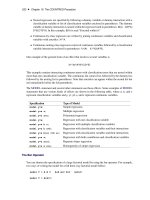SAS/ETS 9.22 User''''s Guide 1 ppt
Bạn đang xem bản rút gọn của tài liệu. Xem và tải ngay bản đầy đủ của tài liệu tại đây (212.85 KB, 10 trang )
SAS/ETS
®
9.22
User’s Guide
SAS
®
Documentation
The correct bibliographic citation for this manual is as follows: SAS Institute Inc. 2010. SAS/ETS
®
9.22 User’s Guide.
Cary, NC: SAS Institute Inc.
SAS/ETS
®
9.22 User’s Guide
Copyright © 2010, SAS Institute Inc., Cary, NC, USA
ISBN 978-1-60764-543-6
All rights reserved. Produced in the United States of America.
For a hard-copy book
: No part of this publication may be reproduced, stored in a retrieval system, or transmitted, in any
form or by any means, electronic, mechanical, photocopying, or otherwise, without the prior written permission of the
publisher, SAS Institute Inc.
For a Web download or e-book
: Your use of this publication shall be governed by the terms established by the vendor at
the time you acquire this publication.
U.S. Government Restricted Rights Notice: Use, duplication, or disclosure of this software and related documentation
by the U.S. government is subject to the Agreement with SAS Institute and the restrictions set forth in FAR 52.227-19,
Commercial Computer Software-Restricted Rights (June 1987).
SAS Institute Inc., SAS Campus Drive, Cary, North Carolina 27513.
1st electronic book, May 2010
1st printing, May 2010
SAS
®
Publishing provides a complete selection of books and electronic products to help customers use SAS software to
its fullest potential. For more information about our e-books, e-learning products, CDs, and hard-copy books, visit the
SAS Publishing Web site at support.sas.com/publishing or call 1-800-727-3228.
SAS
®
and all other SAS Institute Inc. product or service names are registered trademarks or trademarks of SAS Institute
Inc. in the USA and other countries. ® indicates USA registration.
Other brand and product names are registered trademarks or trademarks of their respective companies.
Contents
I General Information 1
Chapter 1. What’s New in SAS/ETS 9.22 . . . . . . . . . . . . . . . . . 3
Chapter 2. Introduction . . . . . . . . . . . . . . . . . . . . . . . . 15
Chapter 3. Working with Time Series Data . . . . . . . . . . . . . . . . . 63
Chapter 4. Date Intervals, Formats, and Functions . . . . . . . . . . . . . . 127
Chapter 5. SAS Macros and Functions . . . . . . . . . . . . . . . . . . 153
Chapter 6. Nonlinear Optimization Methods . . . . . . . . . . . . . . . . 169
II Procedure Reference 191
Chapter 7. The ARIMA Procedure . . . . . . . . . . . . . . . . . . . . 193
Chapter 8. The AUTOREG Procedure . . . . . . . . . . . . . . . . . . . 317
Chapter 9. The COMPUTAB Procedure . . . . . . . . . . . . . . . . . . 463
Chapter 10. The COUNTREG Procedure . . . . . . . . . . . . . . . . . . 517
Chapter 11. The DATASOURCE Procedure . . . . . . . . . . . . . . . . . 563
Chapter 12. The ENTROPY Procedure (Experimental) . . . . . . . . . . . . . 659
Chapter 13. The ESM Procedure . . . . . . . . . . . . . . . . . . . . . 725
Chapter 14. The EXPAND Procedure . . . . . . . . . . . . . . . . . . . 763
Chapter 15. The FORECAST Procedure . . . . . . . . . . . . . . . . . . 817
Chapter 16. The LOAN Procedure . . . . . . . . . . . . . . . . . . . . 871
Chapter 17. The MDC Procedure . . . . . . . . . . . . . . . . . . . . . 913
Chapter 18. The MODEL Procedure . . . . . . . . . . . . . . . . . . . . 993
Chapter 19. The PANEL Procedure . . . . . . . . . . . . . . . . . . . . 1309
Chapter 20. The PDLREG Procedure . . . . . . . . . . . . . . . . . . . 1395
Chapter 21. The QLIM Procedure . . . . . . . . . . . . . . . . . . . . . 1421
Chapter 22. The SEVERITY Procedure (Experimental) . . . . . . . . . . . . . 1491
Chapter 23. The SIMILARITY Procedure . . . . . . . . . . . . . . . . . . 1589
Chapter 24. The SIMLIN Procedure . . . . . . . . . . . . . . . . . . . . 1659
Chapter 25. The SPECTRA Procedure . . . . . . . . . . . . . . . . . . . 1689
Chapter 26. The STATESPACE Procedure . . . . . . . . . . . . . . . . . 1715
Chapter 27. The SYSLIN Procedure . . . . . . . . . . . . . . . . . . . . 1761
Chapter 28. The TIMEID Procedure (Experimental) . . . . . . . . . . . . . . 1825
Chapter 29. The TIMESERIES Procedure . . . . . . . . . . . . . . . . . . 1849
Chapter 30. The TSCSREG Procedure . . . . . . . . . . . . . . . . . . . 1919
Chapter 31. The UCM Procedure . . . . . . . . . . . . . . . . . . . . . 1933
Chapter 32. The VARMAX Procedure . . . . . . . . . . . . . . . . . . . 2047
Chapter 33. The X11 Procedure . . . . . . . . . . . . . . . . . . . . . 2227
Chapter 34. The X12 Procedure . . . . . . . . . . . . . . . . . . . . . 2295
III Data Access Engines 2395
Chapter 35. The SASECRSP Interface Engine . . . . . . . . . . . . . . . . 2397
Chapter 36. The SASEFAME Interface Engine . . . . . . . . . . . . . . . . 2499
Chapter 37. The SASEHAVR Interface Engine . . . . . . . . . . . . . . . . 2555
IV Time Series Forecasting System 2605
Chapter 38. Overview of the Time Series Forecasting System . . . . . . . . . . 2607
Chapter 39. Getting Started with Time Series Forecasting . . . . . . . . . . . . 2611
Chapter 40. Creating Time ID Variables . . . . . . . . . . . . . . . . . . 2667
Chapter 41. Specifying Forecasting Models . . . . . . . . . . . . . . . . . 2681
Chapter 42. Choosing the Best Forecasting Model . . . . . . . . . . . . . . . 2719
Chapter 43. Using Predictor Variables . . . . . . . . . . . . . . . . . . . 2739
Chapter 44. Command Reference . . . . . . . . . . . . . . . . . . . . . 2773
Chapter 45. Window Reference . . . . . . . . . . . . . . . . . . . . . 2781
Chapter 46. Forecasting Process Details . . . . . . . . . . . . . . . . . . 2889
V SAS/ETS Model Editor (Experimental) 2923
Chapter 47. SAS/ETS Model Editor Window Reference . . . . . . . . . . . . 2925
VI Investment Analysis 2977
Chapter 48. Overview . . . . . . . . . . . . . . . . . . . . . . . . . 2979
Chapter 49. Portfolios . . . . . . . . . . . . . . . . . . . . . . . . . 2983
Chapter 50. Investments . . . . . . . . . . . . . . . . . . . . . . . . 2991
Chapter 51. Computations . . . . . . . . . . . . . . . . . . . . . . . 3035
Chapter 52. Analyses . . . . . . . . . . . . . . . . . . . . . . . . . 3047
Chapter 53. Details . . . . . . . . . . . . . . . . . . . . . . . . . . 3063
Subject Index 3075
Syntax Index 3117
iv
Credits and Acknowledgments
Credits
Documentation
Editing Anne Jones
Technical Review
Evan L. Anderson, Ming-Chun Chang, Jan Chvosta,
Brent Cohen, Allison Crutchfield, Paige Daniels, Gül Ege,
Bruce Elsheimer, Donald J. Erdman, Kelly Felling-
ham, Sanggohn Han, Laura Jackson, Wilma S. Jackson,
Wen Ji, Kurt Jones, Kathleen Kiernan, Michael J. Leonard,
Li C. Li, Mark R. Little, Kevin Meyer, Gina Marie Mon-
dello, Steve Morrison, Youngjin Park, Jim Seabolt,
David Schlotzhauer, Rajesh Selukar, Jennifer Sloan,
Mark Traccarella, Michele A. Trovero, Charles Sun,
Donna E. Woodward
Documentation Production Tim Arnold
Software
The procedures in SAS/ETS software were implemented by members of the Advanced Analytics
division. Program development includes design, programming, debugging, support, documentation,
and technical review. In the following list, the name of the developer who currently has principal
support responsibility for the procedure is listed first.
ARIMA Rajesh Selukar, Michael J. Leonard, Terry Woodfield
AUTOREG
Xilong Chen, Jan Chvosta, Richard Potter, Jason Qiao, John P. Sall
COMPUTAB Michael J. Leonard, Alan R. Eaton
COUNTREG Jan Chvosta, Laura Jackson
DATASOURCE Kelly Fellingham, Meltem Narter
ENTROPY Xilong Chen, Arthur Sinko, Greg Sterijevski, Donald J. Erdman
ESM Michael J. Leonard
EXPAND Marc Kessler, Michael J. Leonard, Mark R. Little
FORECAST Michael J. Leonard, Mark R. Little, John P. Sall
LOAN Richard Potter, Gül Ege
MDC Jan Chvosta
MODEL Marc Kessler, Donald J. Erdman, Mark R. Little, John P. Sall
PANEL Jan Chvosta, Greg Sterijevski
PDLREG Xilong Chen, Richard Potter, Jan Chvosta, Leigh A. Ihnen
QLIM Jan Chvosta
SIMILARITY Michael J. Leonard
SEVERITY Mahesh V. Joshi
SIMLIN Mark R. Little, John P. Sall
SPECTRA Marc Kessler, Rajesh Selukar, Donald J. Erdman, John P. Sall
STATESPACE Donald J. Erdman, Michael J. Leonard
SYSLIN Laura. Jackson, Donald J. Erdman, Leigh A. Ihnen, John P. Sall
TIMEID Marc Kessler, Michael J. Leonard
TIMESERIES Marc Kessler, Michael J. Leonard
TSCSREG Jan Chvosta
vi
UCM Rajesh Selukar
VARMAX Youngjin Park
X11 Wilma S. Jackson, R. Bart Killam, Leigh A. Ihnen,
Richard D. Langston
X12 Wilma S. Jackson
Time Series Evan L. Anderson, Michael J. Leonard, Meltem Narter, Gül Ege
Forecasting System
Investment Analysis Gül Ege, Scott Gray, Michael J. Leonard
System
Compiler and Andrew Henrick, Stacey Christian
Symbolic Differentiation
SASEHAVR Kelly Fellingham
SASECRSP Kelly Fellingham, Peng Zang
SASEFAME Kelly Fellingham
Testing
Shu An, Ming-Chun Chang, Bruce Elsheimer, Kelly Fellingham,
Sanggohn Han, Li C. Li, Jennifer Sloan, Charles Sun, Peng Zang
Technical Support
Members
Paige Daniels, Wen Ji, Kurt Jones, Kathleen Kiernan,
Gina Marie Mondello, David Schlotzhauer, Donna E. Woodward
vii
Acknowledgments
Hundreds of people have helped the SAS System in many ways since its inception. The following
individuals have been especially helpful in the development of the procedures in SAS/ETS software.
Acknowledgments for the SAS System generally appear in Base SAS
®
software documentation and
SAS/ETS software documentation.
David Amick Idaho Office of Highway Safety
David M. DeLong Duke University
David Dickey North Carolina State University
Douglas J. Drummond Center for Survey Statistics
Michel Ferland Statistics Canada
Susie Fortier Statistics Canada
William Fortney Boeing Computer Services
Wayne Fuller Iowa State University
A. Ronald Gallant The University North Carolina at Chapel Hill
Phil Hanser Sacramento Municipal Utilities District
Marvin Jochimsen Mississippi R&O Center
Jeff Kaplan Sun Guard
Ken Kraus Center for Research in Security Prices
Dominique Ladiray INSEE
George McCollister San Diego Gas & Electric
Douglas Miller Purdue University
Brian Monsell U.S. Census Bureau
Robert Parks Washington University
Benoit Quenneville Statistics Canada
Gregory Sali Idaho Office of Highway Safety
Bob Spatz Center for Research in Security Prices
Mary Young Salt River Project
The final responsibility for the SAS System lies with SAS Institute alone. We hope that you will
always let us know your opinions about the SAS System and its documentation. It is through your
participation that SAS software is continuously improved.
viii
Part I
General Information

